This butternut squash risotto recipe is the quintessential expression of autumn. It celebrates fall in all the best ways with creamy risotto, colorful squash, and woodsy herbs like rosemary and sage. It’s perfect for a chilly fall evening.

I make butternut squash risotto so often in fall that I sometimes forget I didn’t grow up eating it. This gorgeous golden-hued dish hails from Italy’s northern Veneto region, where yellow-fleshed pumpkins grow in abundance and starchy short-grain rice is a staple.
My family comes from central-southern Italy, where pasta is more common than rice, and where broccoli, cauliflower, and hearty greens are autumn’s vegetable stars.
But ever since I stirred up my first batch of risotto alla zucca (as it is called in Italian) when my kids were little, it’s been a family favorite. The combination of sweet butternut squash, savory herbs, and creamy rice is irresistible.
I know there are plenty of shortcut butternut squash risotto recipes out there, but I’m a traditionalist when it comes to this dish. The deliberate stirring, whether I’m making Mushroom or Asparagus Risotto in the spring or this fall favorite, or Risotto alla Milanese all year round, is part of the enjoyment.
I like to watch the transformation as the grains of rice plump up and the golden pieces of squash slowly melt into the pot. In less than an hour, I can put an elegant, comforting dish of risotto on the table.
Table of Contents

Butternut Squash Risotto Recipe Ingredients
Making butternut squash risotto takes some time, but the delicious result is worth it. Having to peel and cut up a dense, thick-rind squash may seem daunting but it’s a skill worth learning. Just scroll down to the tips below for detailed instructions. As with most Italian dishes, the quality of ingredients matters. Here’s what you’ll need.
- Chicken or vegetable broth: I make homemade broth regularly and keep it in tightly lidded containers in the freezer. For chicken broth, I use the method in my Italian Wedding Soup recipe. You could also use this recipe for How to Make Chicken Stock. For vegetable broth, I simmer onions, celery, carrots, fennel with some herbs and spices in a big pot of water until they have given up their flavors. Then I strain the broth through a fine-mesh sieve and simmer it to concentrate the flavors even more.
- Butternut squash: This curvy winter squash has a mild, sweet flavor and pretty orange flesh, which is just what you want for this risotto. You’ll need one medium squash weighing about 1 1/2 pounds. This yields just about 3 packed cups or 1 pound cubed squash. Many supermarkets now sell butternut squash already peeled and cubed, which is convenient. But a whole squash is less expensive, and it’s worth learning how to peel and cut it yourself (see Tips for Peeling and Cutting Butternut Squash below).
- Extra-virgin olive oil and butter: Although butter is the traditional fat in this northern Italian dish, I use mostly extra-virgin olive oil as it is more healthful, and I love the flavor. I stir in a small knob of butter at the end of cooking to give the risotto a luxurious sheen and an extra layer of richness, but you can also leave this out.
- Onion: One small yellow onion, about 3/4 cup finely diced and sautéed until soft and pale gold, gives the risotto an aromatic foundation.
- Sage and rosemary: These two woodsy, resinous herbs punch up the flavors in butternut squash risotto and beautifully complement the sweet squash. (P.S. If you’re a big fan of sage, check out our Chicken Saltimbocca and Braised Chicken Breast with Caramelized Shallots and Sage.)
- Carnaroli or Arborio rice: Both of these starchy, short-grain Italian rice varieties are perfect for risotto. Italians have a slight preference for Carnaroli, which has the largest, starchiest grains, but Arborio is more readily available in the U.S. and will make a fine pot of risotto. If you want to go with Carnaroli, you’ll likely find it at an Italian grocery. It’s also available online.
- White wine: This is optional, but I find that white wine brings welcome acidity and depth to this risotto. Use a crisp white, such as Sicilian Grillo, but really any nice white like chardonnay or pinot grigio will do.
- Parmigiano cheese: For the ultimate umami touch, don’t forget to stir in a handful of freshly grated parmesan cheese when your risotto is finished cooking. To make this recipe truly vegetarian look for vegetarian parmesan cheese.
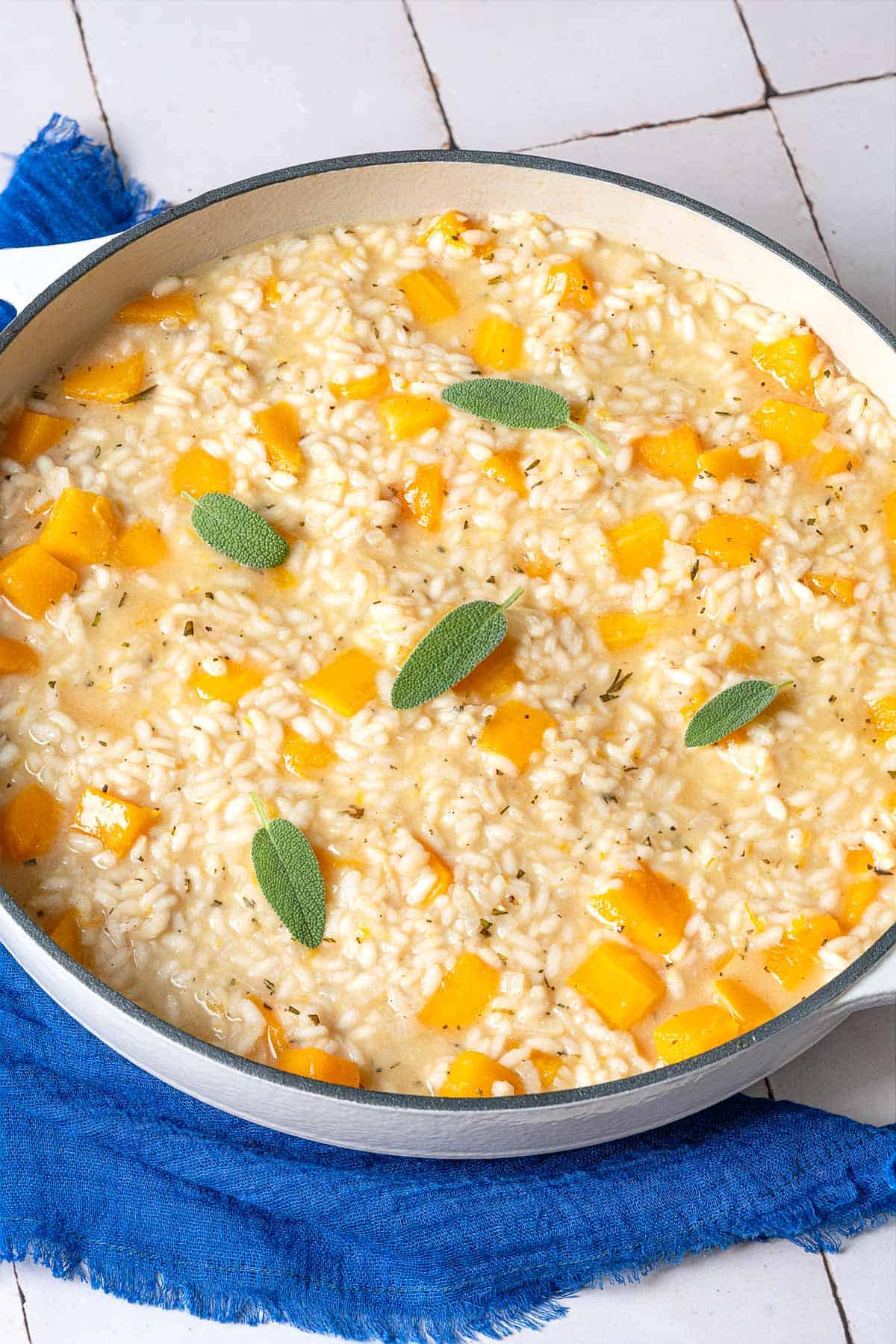
How to Make Butternut Squash Risotto
The two most onerous tasks—if they can even be called that—are peeling and cubing the squash and stirring the risotto. But if you have the right tools and a little time, making this risotto recipe is satisfying, even therapeutic!
- Heat the broth: Pour 6 cups of broth into a medium pot and set it over medium heat. Bring it to a low simmer, then reduce the heat and cover the pot to keep it warm.
- Prep the squash: Use a sharp, sturdy knife to trim off the ends. Cut the squash in half so you have the bulbous end and the neck. Working with one section at a time, use the knife or a Y-shaped vegetable peeler to remove the tough outer skin of the squash. Cut each section in half and use a spoon to scoop out the seeds from the bulbous end. Cut the peel squash into 3/4-inch cubes.
- Sauté the onion: Into a large deep skillet, 3 tablespoons extra-virgin olive oil and add the onion. Cook on medium-low until the onion is soft and a pale golden color. This will take about 8 minutes. Add the squash chunks and stir to coat them with oil. Cook for about 10 minutes, until the squash is beginning to soften but is still quite firm. Season with 1/2 teaspoon salt, a grinding of black pepper, and 1 tablespoon each of finely chopped rosemary and sage—about 2 teaspoons each. Cook until the squash is just tender, about 4 minutes longer. Then scoop out half the pieces of squash and set them aside in a bowl. These will be added back later.
- Add the rice. Stir in 1 1/2 cups of rice, and “toast” it, coating it well with oil and stirring for 3 to 5 minutes, until it is pearly and translucent, and you start to hear it crackle. If the pot seems dry, add another tablespoon of olive oil. Season with 1/2 teaspoon salt—unless your broth is already salted. When the rice is ready, pour in 1/2 cup wine and let it bubble. Stir until all the wine is absorbed. Ladle in 3/4 to 1 cup of hot broth, stirring with a sturdy hand and a circular motion. Keep stirring until the broth is completely absorbed. Continue to add broth by the ladleful, stirring regularly and allowing the rice to absorb the liquid before adding more.
- Add the reserved squash. After 15 minutes of cooking the rice, stir in the reserved pieces of squash. Continue to cook the risotto, adding broth as needed, until the risotto is creamy and al dente. Taste a small spoonful; the grains should be tender with just a tiny bit of firmness at the center, but no chalkiness. If the rice is chalky, add another ladleful of broth and stir until the rice is creamy and al dente. Add a final splash of broth to give the risotto its signature “wavy” or “flowing” consistency; it should be slightly runny but still spoonable.
- Finish the risotto and serve. Remove the pot from the heat and stir in a handful—about 1/2 cup—of parmesan cheese and a knob of butter (optional), about 1 tablespoon. Stir vigorously until the cheese and butter are fully incorporated. Spoon the risotto into bowls and serve while still hot and creamy, with a sprinkle of parmesan on top of each serving.

How to Peel and Cut Butternut Squash
The idea of slicing into a hard object that rolls around on the cutting board strikes fear in the hearts of some cooks, even seasoned ones. Yet, it’s a good skill to have, and mastering it will make you more confident in the kitchen. Follow these tips and you’ll see it’s a fairly simple process after all.
- Use the right tools. You’ll need a large cutting board that doesn’t slide. I use one with rubber grips, but you can also place a slightly damp kitchen towel under your cutting board to help keep it in place. You’ll also need a sharp, sturdy chef’s knife that can slice through the rind and the flesh of the squash. For peeling the rind, I find a Y-shaped vegetable peeler works best. It allows you to keep a firm grip on the peeler while taking off the rind in large strokes.
- Start at the end. Trim off the ends first. Keeping a firm hand on the bulbous bottom end of the squash, slice off the top where the stem is. Then turn the squash around and hold it firm by the neck, slice off the bottom.
- Peel the squash. Holding the squash firmly in one hand, with the angled bottom resting on the cutting board, peel the rind off in vertical strokes. If it’s easier, you can stand the squash upright on the cutting board and peel downwards. If you find the squash is too large and unwieldy, cut it in half crosswise, right where the neck meets the bulbous bottom and peel each half separately.
- Cut the squash into large pieces. If you haven’t already, cut the squash in half crosswise; then cut each piece in half again, this time lengthwise. Use a spoon to scoop out the seeds from the two bottom halves. (Save the seeds for later, if you like; you can clean them, season them, and toast them in the oven for a snack similar to how you would roast pumpkin seeds.)
- Cut the pieces into cubes. You should have four pieces of squash. Lay one flat on the cutting board and cut it lengthwise into 3/4-inch-wide slices. Lay the slices on their sides and cut them in half lengthwise to make batons approximately 3/4-inch thick. Line up the batons and cut them crosswise into 3/4-inch cubes. Cut the remaining three pieces in the same way. A 1 1/2-pound squash yields approximately 3 cups of cubed flesh, which is what you want for your risotto.
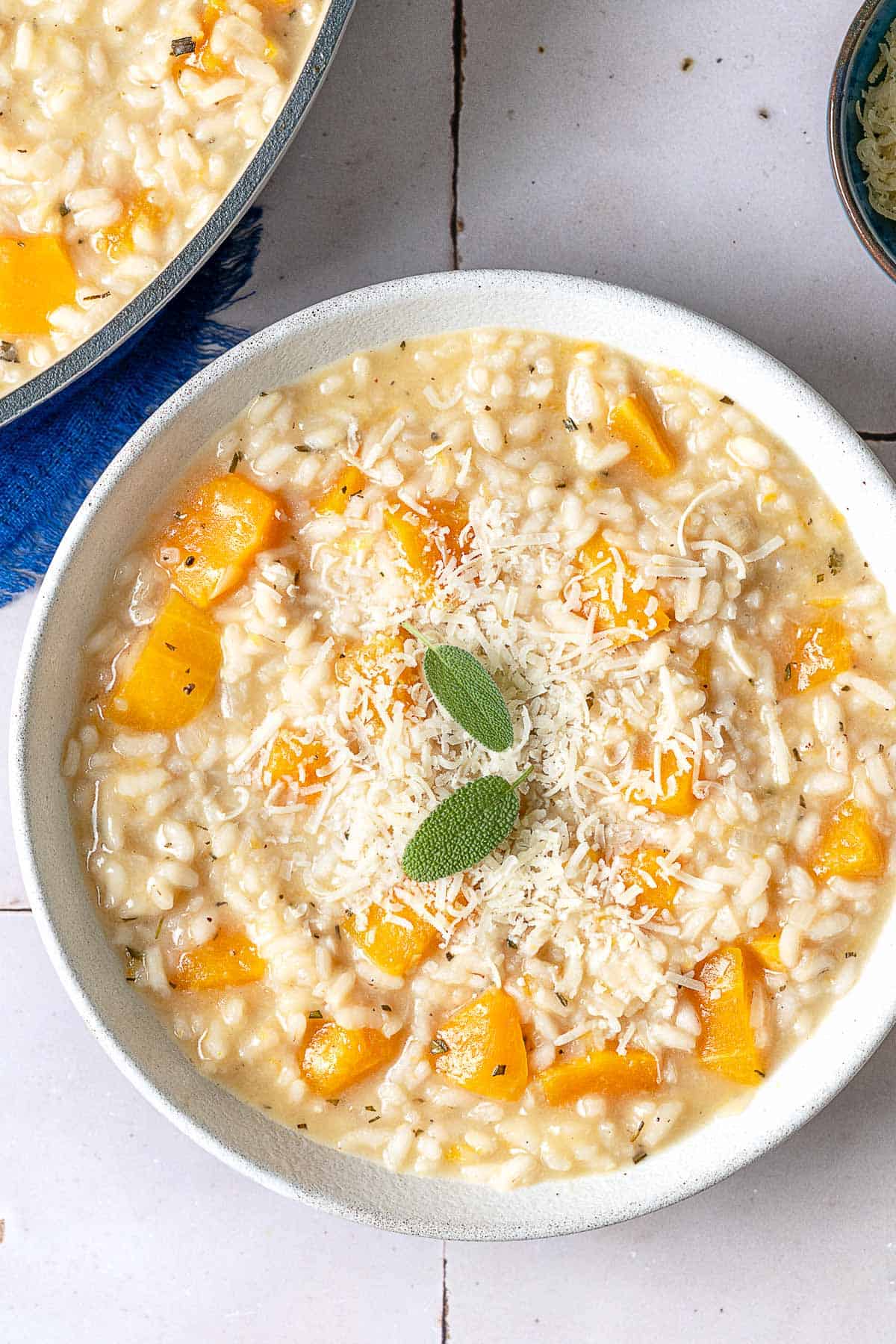
Tips for Making Risotto
You want the risotto to be wavy meaning there is some moisture to it and it should be creamy. you don’t want overly thick, dry, or clumpy risotto.
- Choose the right rice. Proper risotto requires the type of starchy short-grain rice that grows in northern Italy. There are numerous varieties, but most common are Arborio, Carnaroli, and Vialone Nano. There are slight differences in the size of the grains, Carnaroli being the largest and Vialone Nano the smallest. Carnaroli also has the highest amount of starch, which produces the creamiest risotto. But Arborio is a close second, and it is easier to find than Carnaroli. Most well-stocked supermarkets carry Arborio, but you may have to resort to the internet for Carnaroli. Vialone Nano, with its small pebble-shaped grain, is somewhat less starchy than the other two. It works especially well in seafood risottos and in rice salads.
- Use a heavy-bottomed pot. I use a medium enamel-coated Dutch oven or high-sided sauté pan to cook risotto. The heavy bottom makes for even cooking and prevents vegetables or rice from burning.
- “Toast” the rice. Before you add broth or stock to the pan, sauté the rice (along with any aromatic vegetables) for a couple of minutes until the grains take on a glassy, translucent appearance and almost start crackling. This step deepens the flavor of the grains and the risotto.
- Have broth ready. Warm your broth or stock in a separate pot until it is just below a simmer. Lower the heat and cover the pot to keep the broth hot. The hot broth helps the rice grain release their starch, which means a creamier risotto.
- Add the broth by the ladleful. It’s tempting to add large quantities of broth all at once to speed up the cooking process and reduce the amount of stirring needed, or to follow other popular shortcuts. But the truth is, risotto is best when you add broth by the ladleful (3/4 to 1 cup at a time) and allow the grains to fully absorb the liquid before adding more.
- Stir. Does risotto require constant stirring? Not quite, but it does require regular stirring. In reality, this amounts to 25 minutes spent at the stovetop, a small price to pay for a nice dish of creamy risotto. Stir in a clockwise motion with intention. You don’t have to give it all your strength, but make sure you’re using a little muscle to help coax the starch out of the rice.
- Finish. How do you know when this butternut squash risotto recipe is ready? Taste a small spoonful. The grains of rice should be al dente—slightly firm in the center, but not chalky. At this point, add just enough broth to make sure the risotto is “all’onda,” wavy and creamy, with grains almost suspended in starchy liquid. Take care not to let the risotto cook for any longer or it will turn clumpy. Now is the time to remove it from the heat and stir in a handful of finely grated Parmigiano cheese and a small knob of butter to give the risotto a glossy finish.
- Serve. Don’t wait even a minute to serve your risotto. The longer it sits, the denser it gets, as the grains of rice continue to soak up broth. It should be hot and just runny enough to spread slightly as you spoon it into bowls.
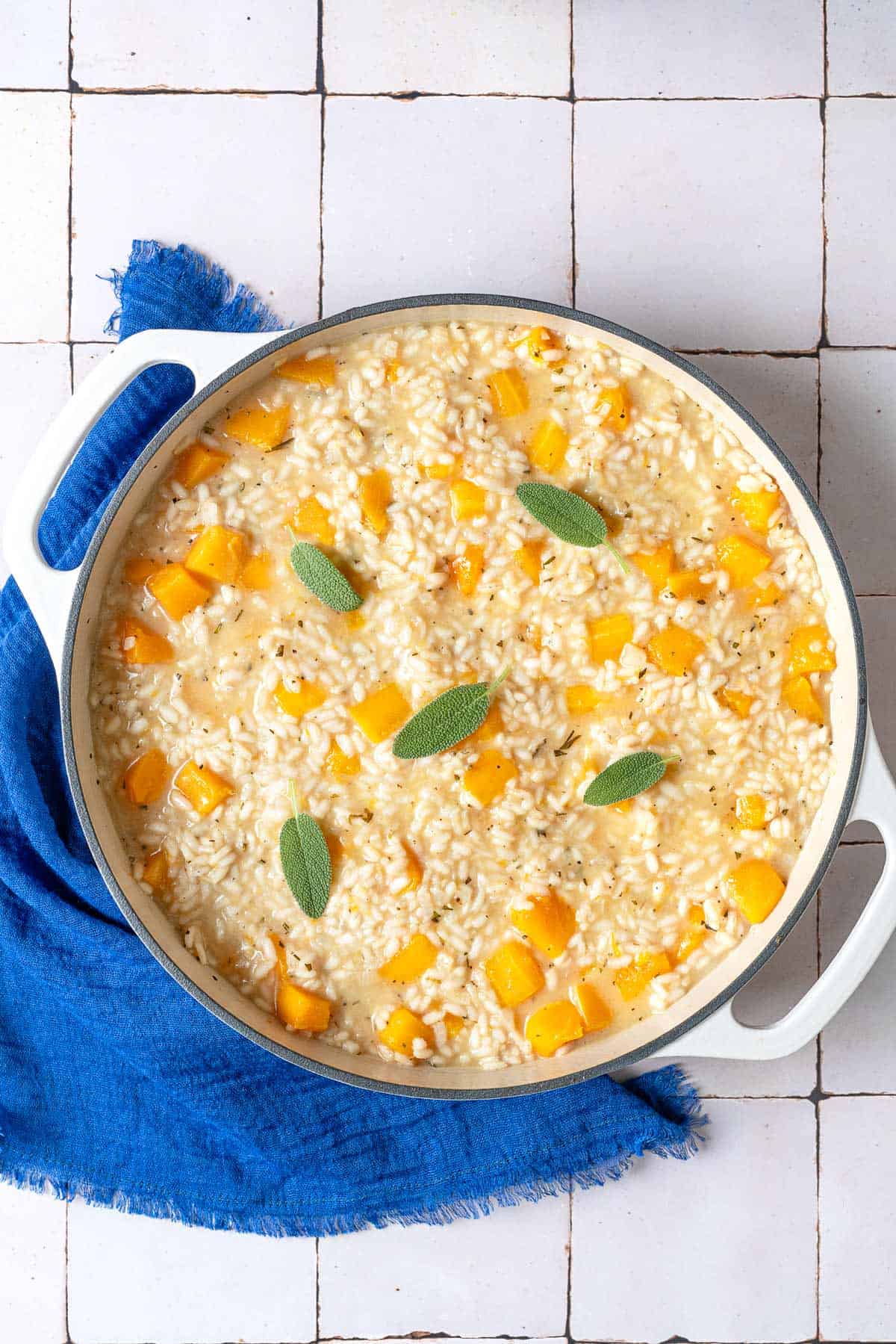
What to Serve with Butternut Squash Risotto
The lovely thing about this dish—and many risotti—is that they can stand on their own as an entrée, or they can be served as a first course or even a side dish.
I like to pair butternut squash risotto with this Fennel and Orange Salad or Lemon Parmesan Salad. If I’m making it as part of a larger meal, say for a dinner party, I serve the risotto as a primo piatto (first course), followed by juicy pork chops or slow-roasted salmon and lemon parmesan salad.
If you’re looking for more ways to use butternut squash try it in this Butternut Squash and Apple Roasted Pork Loin or this Kale Butternut Squash Salad.
More Amazing Risotto Recipes
Browse all Mediterranean recipes.
Visit Our Shop
Bundle and Save!
Four of our best-selling signature olive oils, perfect for everyday use.

Butternut Squash Risotto with Rosemary and Sage

Ingredients
- 6 cups low sodium vegetable or chicken broth
- 1 (1 1/2 pound) butternut squash or 3 cups cubed butternut squash
- 3 tablespoons extra-virgin olive oil, plus more as necessary
- 1 small yellow onion, finely diced (about 3/4 cup)
- Kosher salt
- Freshly ground black pepper
- 1 tablespoon finely chopped rosemary
- 1 tablespoon finely chopped sage
- 1 1/2 cups Arborio or Carnaroli rice
- 1/2 cup dry white wine
- 1/2 cup freshly grated parmesan cheese, plus more for serving
- 1 tablespoon butter (optional)
Instructions
- Heat the broth: Pour the broth into a medium saucepan and warm it over medium heat until it is almost at a simmer. Reduce the heat to low and cover the pan to keep the broth warm.
- Prep the squash: If using whole squash, trim and peel it (see "Tips for Peeling and Cutting Butternut Squash" section above). Remove the seeds and stringy flesh. Cut the squash into 3/4-inch cubes. You should have 3 cups (save any extra for another use; it’s delicious seasoned with salt and pepper and roasted).
- Sauté the vegetables: Measure 3 tablespoons extra-virgin olive oil into a deep skillet or heavy-bottomed sauté pan and add the onion. Set on medium-low and cook 8 minutes, until the onion is soft and pale gold. Add the squash cubes and stir to coat them with oil. Cook, stirring often, until the squash is just starting to soften but is still quite firm, about 10 minutes. Season with 1/2 teaspoon salt, a grinding of black pepper, and the rosemary and sage. Cook 4 minutes longer, until the squash is just tender but still firm enough to hold its shape. Scoop out half the pieces and set them aside in a bowl.
- Stir in the rice: Add the rice and toast it, coating it well with oil and stirring for 3 to 5 minutes, until it is pearly and translucent and you start to hear it crackle. Add another tablespoon of olive oil if the bottom of the pot seems dry. Season with 1/2 teaspoon salt (unless your broth is already salted).
- Add the wine: Add the wine and let it bubble briefly, stirring until it is absorbed. Ladle in 3/4 cup of hot broth and stir. Keep stirring until the broth is completely absorbed. Then add another ladleful, stirring regularly and allowing the rice to absorb the liquid before adding more.
- Finish cooking the risotto: After 15 minutes, stir in the reserved pieces of squash. Continue to cook the risotto, adding a ladleful of broth and stirring, until creamy and the rice is al dente. Taste a small spoonful; the grains should be tender with just a tiny bit of firmness at the center, but no chalkiness. If the rice is chalky, add another ladleful of broth and stir until the rice is creamy and al dente. Add a final splash of broth to give the risotto its signature “wavy” or “flowing” consistency; it should be slightly runny but still spoonable.
- Finish the dish and serve: Remove the pot from the heat and stir in the parmesan cheese and butter (if using). Stir vigorously until the cheese and butter are fully incorporated. Spoon the risotto into bowls and serve while still hot and creamy, with a sprinkle of cheese on top of each serving.
Video
Notes
- For any leftover butternut squash, try: Butternut Squash Pasta with Roasted Garlic, Simple Roasted Butternut Squash with Lime and Hazelnut, or Easy Butternut Squash Recipe with Lentils and Quinoa,
- Visit our shop to browse quality Mediterranean ingredients including olive oils, honey, jams, and spices.



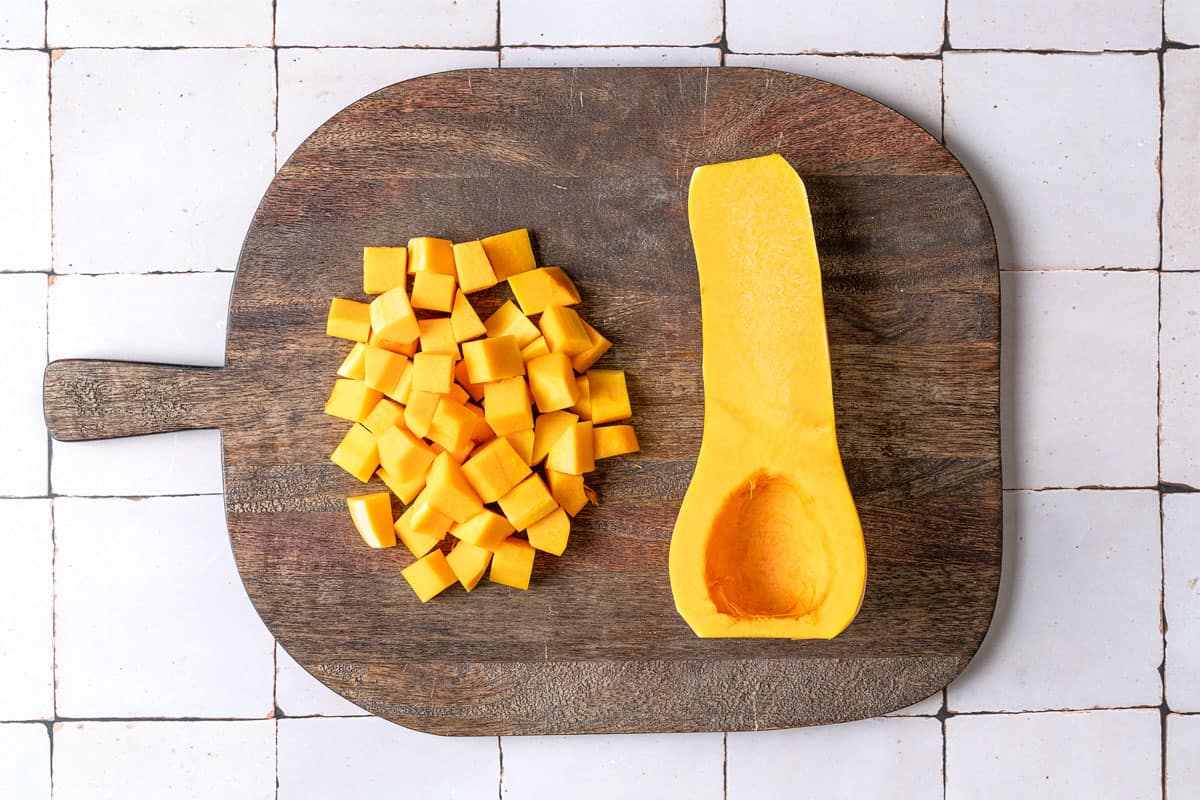



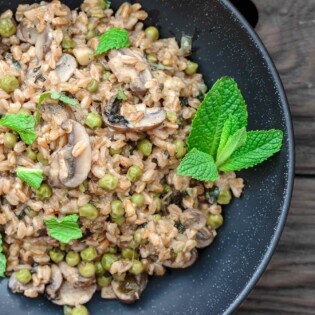



Can this be made ahead of time?
I’m thinking about serving it for a dinner party, but I will not have time to nurse this dish for an hour while my guests are here.
Hi, Dee! We don’t really recommend making risotto in advance because, as the rice cools down, it continues to absorb the liquid, removing that lovely creaminess. However, if you want to give it a try, you’ll want to cook it most of the way through first, to the point the rice grains are no longer solid but still have a bit of crunch. Then, turn off the heat and reserve it. Once you’re about ready to serve, add a bit more stock, and cook until the rice is al dente. Finally, finish with the parmesan cheese and butter (if using).
What can i substitute for the dry white wine – looking for non-alcoholic replacement
Hi, Shirley! I’m Summer and I work here at The Mediterranean Dish. You can just skip the wine and use a little extra stock instead. Enjoy!